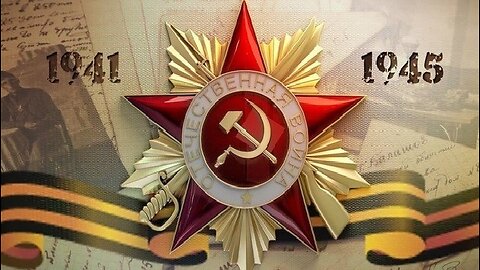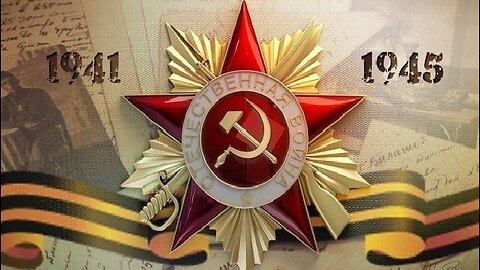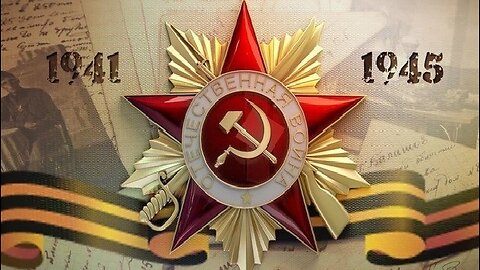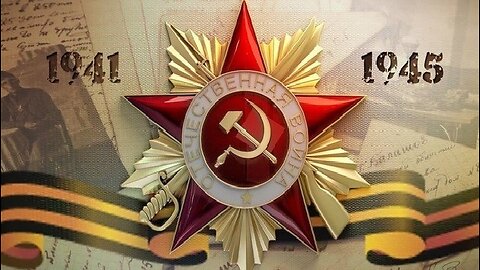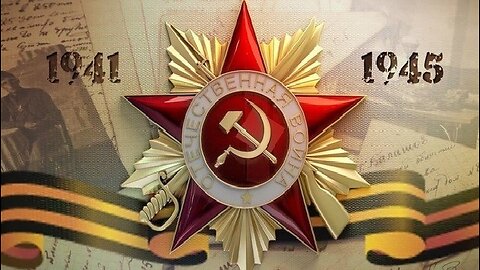
Soviet Storm - WWII in the East (Doc Series 2011)
18 videos
Updated 4 months ago
-
Soviet Storm: World War II in the East | Operation Barbarossa (Episode 1)
 Adaneth - History&PoliticsA 2011 Channel One Russia WWII Documentary series, produced by Star Media and Babich-Design. English narration by David Riley and Mike Cooper. Episode 1: The Battle of Britain is over. The Luftwaffe has been driven to exhaustion, and Germany suffers its first major defeat. Even though Britain remains undefeated, it is so isolated that Hitler has no concerns about turning his attention East. Just a few officers of the Soviet Command doubted that there would be war with Germany. But what was the timing? The scout reports were controversial. In April 1940 Hitler signed the operation Barbarossa, and heavy war machinery started making its way to the boundaries of the USSR. However, the very first battles in June 1941 at the border at the Brest Fortress, near Kiev and Minsk broke the German design of Blitzkrieg, a ‘lightning war’. Operation Barbarossa, the German invasion of the USSR, takes the Soviets completely by surprise and the Red Army suffers terrible casualties. Note: The series consists of 2 seasons (18 Episodes in totale). But since I'm uploading them in one go, I will follow a chronological order. At least the episodes about specific operations&battles. Unfortunately, the maps are in Cyrillic, only. But it's not a big problem if you're already a bit familiar with WWII in the Eastern Front. Episode 2: https://rumble.com/v2pngzk-soviet-storm-world-war-ii-in-the-east-the-battle-of-kiev-1941-episode-2.html595 views 3 comments
Adaneth - History&PoliticsA 2011 Channel One Russia WWII Documentary series, produced by Star Media and Babich-Design. English narration by David Riley and Mike Cooper. Episode 1: The Battle of Britain is over. The Luftwaffe has been driven to exhaustion, and Germany suffers its first major defeat. Even though Britain remains undefeated, it is so isolated that Hitler has no concerns about turning his attention East. Just a few officers of the Soviet Command doubted that there would be war with Germany. But what was the timing? The scout reports were controversial. In April 1940 Hitler signed the operation Barbarossa, and heavy war machinery started making its way to the boundaries of the USSR. However, the very first battles in June 1941 at the border at the Brest Fortress, near Kiev and Minsk broke the German design of Blitzkrieg, a ‘lightning war’. Operation Barbarossa, the German invasion of the USSR, takes the Soviets completely by surprise and the Red Army suffers terrible casualties. Note: The series consists of 2 seasons (18 Episodes in totale). But since I'm uploading them in one go, I will follow a chronological order. At least the episodes about specific operations&battles. Unfortunately, the maps are in Cyrillic, only. But it's not a big problem if you're already a bit familiar with WWII in the Eastern Front. Episode 2: https://rumble.com/v2pngzk-soviet-storm-world-war-ii-in-the-east-the-battle-of-kiev-1941-episode-2.html595 views 3 comments -
Soviet Storm: World War II in the East | The Battle of Kiev - 1941 (Episode 2)
 Adaneth - History&PoliticsEpisode 2: After the swift success at Smolensk, Hitler has diverted the bulk of Heinz Guderian's panzers down to the South, so as to capture the Ukrainian capital Kiev, considered more important than Moscow in Hitler's mind. It begins a gigantic clash and turns out to be the biggest military encirclement in history. Despite heroic and long resistance, approximately six hundred and fifty thousand Soviet soldiers face captivity or death. Episode 3: https://rumble.com/v2pnnii-soviet-storm-world-war-ii-in-the-east-the-defence-of-sevastopol-episode-3.html286 views
Adaneth - History&PoliticsEpisode 2: After the swift success at Smolensk, Hitler has diverted the bulk of Heinz Guderian's panzers down to the South, so as to capture the Ukrainian capital Kiev, considered more important than Moscow in Hitler's mind. It begins a gigantic clash and turns out to be the biggest military encirclement in history. Despite heroic and long resistance, approximately six hundred and fifty thousand Soviet soldiers face captivity or death. Episode 3: https://rumble.com/v2pnnii-soviet-storm-world-war-ii-in-the-east-the-defence-of-sevastopol-episode-3.html286 views -
Soviet Storm: World War II in the East | The Defence of Sevastopol (Episode 3)
 Adaneth - History&PoliticsEpisode 3: Hitler’s 1941 invasion of the USSR ran into some its fiercest resistance at the Black Sea ports of Odessa and Sevastopol, where Soviet elite naval infantry brigades fought doggedly to hold back German and Romanian troops. At Sevastopol, a long and bloody siege unfolded, causing the Germans to bring in some of the biggest artillery guns ever used. Erich von Manstein's soldiers have trapped a massive Soviet force in Crimea, but the doomed troops have no intentions of surrendering, strongly motivated by patriotism. Manstein assembles the greatest concentration of artillery in history, which includes the world's biggest railway-gun nicknamed "Dora," and for eight months Soviets troops are savagely bombarded; destroying Sevastopol's only harbor. Realizing the battle is hopelessly lost, the Soviet forces finally surrender. Episode 4: https://rumble.com/v2pnx7w-soviet-storm-world-war-ii-in-the-east-the-battle-of-moscow-episode-4.html248 views 2 comments
Adaneth - History&PoliticsEpisode 3: Hitler’s 1941 invasion of the USSR ran into some its fiercest resistance at the Black Sea ports of Odessa and Sevastopol, where Soviet elite naval infantry brigades fought doggedly to hold back German and Romanian troops. At Sevastopol, a long and bloody siege unfolded, causing the Germans to bring in some of the biggest artillery guns ever used. Erich von Manstein's soldiers have trapped a massive Soviet force in Crimea, but the doomed troops have no intentions of surrendering, strongly motivated by patriotism. Manstein assembles the greatest concentration of artillery in history, which includes the world's biggest railway-gun nicknamed "Dora," and for eight months Soviets troops are savagely bombarded; destroying Sevastopol's only harbor. Realizing the battle is hopelessly lost, the Soviet forces finally surrender. Episode 4: https://rumble.com/v2pnx7w-soviet-storm-world-war-ii-in-the-east-the-battle-of-moscow-episode-4.html248 views 2 comments -
Soviet Storm: World War II in the East | The Battle of Moscow (Episode 4)
 Adaneth - History&PoliticsEpisode 4: From the very first days of the war the USSR capital had been preparing its defense. Institutions and plants, embassies and ministries were evacuated. In order to organize the defense of Moscow and stifle the German offensive, Marshal Zhukov was called from Leningrad to Moscow. October 1941, Germany's Army Group Center is only some 25 km west of Moscow. The Russian winter, however, is only a few weeks away. With not enough soldiers or military equipment, the Soviet high command's only hope left is that the weather will save the capital. The battle ends in a bloody failure for the German Army, and it is forced to retreat. Episode 5: https://rumble.com/v2psd56-soviet-storm-world-war-ii-in-the-east-the-siege-of-leningrad-episode-5.html280 views 3 comments
Adaneth - History&PoliticsEpisode 4: From the very first days of the war the USSR capital had been preparing its defense. Institutions and plants, embassies and ministries were evacuated. In order to organize the defense of Moscow and stifle the German offensive, Marshal Zhukov was called from Leningrad to Moscow. October 1941, Germany's Army Group Center is only some 25 km west of Moscow. The Russian winter, however, is only a few weeks away. With not enough soldiers or military equipment, the Soviet high command's only hope left is that the weather will save the capital. The battle ends in a bloody failure for the German Army, and it is forced to retreat. Episode 5: https://rumble.com/v2psd56-soviet-storm-world-war-ii-in-the-east-the-siege-of-leningrad-episode-5.html280 views 3 comments -
Soviet Storm: World War II in the East | The Siege of Leningrad (Episode 5)
 Adaneth - History&PoliticsEpisode 5: Leningrad, a vital and large Baltic sea port, is facing the entire weight of Army Group North. On the 8th of September 1941 the Germans reached Lake Ladoga and the city turned out to be cut off from the 'mainland'. The Soviets have no reserves to spare as the Battle of Moscow is about to begin. Death from starvation began to threaten the population of Leningrad. The ships of the Baltic Fleet, anti-aircraft guns, artillery and troops of the Red Army defended the city and the 'life road' that became operable after the frosts. Multiple attempts of the Soviet Command to break though the encirclement failed one after another. Wilhelm von Leeb's Army Group North fails to take Leningrad, but begins a horrible siege that will last 872 days, in which over a million civilians will die of starvation and disease. Episode 6: https://rumble.com/v2qlm98-soviet-storm-world-war-ii-in-the-east-the-rzhev-meat-grinder-episode-6.html269 views 1 comment
Adaneth - History&PoliticsEpisode 5: Leningrad, a vital and large Baltic sea port, is facing the entire weight of Army Group North. On the 8th of September 1941 the Germans reached Lake Ladoga and the city turned out to be cut off from the 'mainland'. The Soviets have no reserves to spare as the Battle of Moscow is about to begin. Death from starvation began to threaten the population of Leningrad. The ships of the Baltic Fleet, anti-aircraft guns, artillery and troops of the Red Army defended the city and the 'life road' that became operable after the frosts. Multiple attempts of the Soviet Command to break though the encirclement failed one after another. Wilhelm von Leeb's Army Group North fails to take Leningrad, but begins a horrible siege that will last 872 days, in which over a million civilians will die of starvation and disease. Episode 6: https://rumble.com/v2qlm98-soviet-storm-world-war-ii-in-the-east-the-rzhev-meat-grinder-episode-6.html269 views 1 comment -
Soviet Storm: World War II in the East | The Rzhev "Meat-Grinder" (Episode 6)
 Adaneth - History&PoliticsEpisode 6: The German conquests of 1941 left Hitler’s troops perilously close to the Soviet capital, Moscow. Around Rzhev terrible fighting raged as the Red Army attacked again and again to drive back the invader. The capture of Rzhev, the city that connects all railroads in Western Russia, is imperative. It will cost the lives of some 3 million Soviet soldiers and 500.000 German soldiers. It will take the Soviets a total of 3 years to throw the Germans firmly out of the city. These bloodbaths will become known by the veterans and historians as "The Rzhev Meat-Grinder" Episode 7: https://rumble.com/v2qma6y-soviet-storm-world-war-ii-in-the-east-the-battle-of-stalingrad-episode-7.html255 views 2 comments
Adaneth - History&PoliticsEpisode 6: The German conquests of 1941 left Hitler’s troops perilously close to the Soviet capital, Moscow. Around Rzhev terrible fighting raged as the Red Army attacked again and again to drive back the invader. The capture of Rzhev, the city that connects all railroads in Western Russia, is imperative. It will cost the lives of some 3 million Soviet soldiers and 500.000 German soldiers. It will take the Soviets a total of 3 years to throw the Germans firmly out of the city. These bloodbaths will become known by the veterans and historians as "The Rzhev Meat-Grinder" Episode 7: https://rumble.com/v2qma6y-soviet-storm-world-war-ii-in-the-east-the-battle-of-stalingrad-episode-7.html255 views 2 comments -
Soviet Storm: World War II in the East | The Battle of Stalingrad (Episode 7)
 Adaneth - History&PoliticsEpisode 7: After the failure to take both Moscow and Leningrad, Hitler sets his sights on the oil fields in the Caucasus. On the 28th of June 1943 German troops launched Case Blue. They dashed towards Voronezh, Stalingrad, and Rostov-on-Don. The insufficiently embattled south sector of the Soviet-German front was breached. The retreat of the Soviet troops Eastward was going on when a famous order later called “Not a Step Back!” was issued. Special anti-retreat detachments were supposed to stop fleeing military units. If Stalingrad was captured, the Red Army will lose 70%-90% of all its oil resources. Therefore, the famous city on the Volga, Stalingrad, must be "held at all costs." The German General Staff thinks taking the city will be a matter of a few weeks, but events steadily turn against the Germans. It will be one of the most costly, famous, and decisive battles of the Second World War. Episode 8: https://rumble.com/v2qmyp0-soviet-storm-world-war-ii-in-the-east-the-battle-of-the-caucasus-episode-8.html351 views 2 comments
Adaneth - History&PoliticsEpisode 7: After the failure to take both Moscow and Leningrad, Hitler sets his sights on the oil fields in the Caucasus. On the 28th of June 1943 German troops launched Case Blue. They dashed towards Voronezh, Stalingrad, and Rostov-on-Don. The insufficiently embattled south sector of the Soviet-German front was breached. The retreat of the Soviet troops Eastward was going on when a famous order later called “Not a Step Back!” was issued. Special anti-retreat detachments were supposed to stop fleeing military units. If Stalingrad was captured, the Red Army will lose 70%-90% of all its oil resources. Therefore, the famous city on the Volga, Stalingrad, must be "held at all costs." The German General Staff thinks taking the city will be a matter of a few weeks, but events steadily turn against the Germans. It will be one of the most costly, famous, and decisive battles of the Second World War. Episode 8: https://rumble.com/v2qmyp0-soviet-storm-world-war-ii-in-the-east-the-battle-of-the-caucasus-episode-8.html351 views 2 comments -
Soviet Storm: World War II in the East | The Battle of the Caucasus (Episode 8)
 Adaneth - History&PoliticsEpisode 8: In 1942 Hitler launched his great summer offensive against the Soviet oil fields in the Caucasus. If he could seize control of this vital resource, the war might be lost. Ewald von Kleist has broken through to the Terek river, slap in front of the vital oil fields of Grozny and Baku. Only freezing temperatures in the Caucasus prevent von Kleist's 1st Panzer Army from breaking through to Ozoni Kizi and Tbilisi. The Soviets launch a desperate counter-attack that holds the Germans back. After the winter, Hitler makes a series of strategic blunders with von Kleist's forces, and he is forced to withdraw all his troops in the Caucasus to the Kuban bridge-head. Episode 8: https://rumble.com/v2qnjcy-soviet-storm-world-war-ii-in-the-east-the-battle-of-kursk-episode-9.html289 views
Adaneth - History&PoliticsEpisode 8: In 1942 Hitler launched his great summer offensive against the Soviet oil fields in the Caucasus. If he could seize control of this vital resource, the war might be lost. Ewald von Kleist has broken through to the Terek river, slap in front of the vital oil fields of Grozny and Baku. Only freezing temperatures in the Caucasus prevent von Kleist's 1st Panzer Army from breaking through to Ozoni Kizi and Tbilisi. The Soviets launch a desperate counter-attack that holds the Germans back. After the winter, Hitler makes a series of strategic blunders with von Kleist's forces, and he is forced to withdraw all his troops in the Caucasus to the Kuban bridge-head. Episode 8: https://rumble.com/v2qnjcy-soviet-storm-world-war-ii-in-the-east-the-battle-of-kursk-episode-9.html289 views -
Soviet Storm: World War II in the East | The Battle of Kursk (Episode 9)
 Adaneth - History&PoliticsEpisode 9: It was April 1943. The frontline froze, but the Soviet Command was already designing plans for the Summer, paying special attention to the Kursk region. Here the troops of the Central Front had deeply bucked in the German defenses. The Germans planned to cut off the Kursk bulge with a double blow during Operation Citadel. Army Group Center was supposed to attack from the North and troops of Army Group South were to attack from the south. Soviets commenced their Kursk Strategic Offensive Operation with the launch of Operation Kutuzov against the rear of the German forces in the northern side. On the southern side, the Soviets also launched powerful counterattacks the same day, one of which led to a large armoured clash, the Battle of Prokhorovka. On 3 August, the Soviets began the second phase of the Kursk Strategic Offensive Operation with the launch of Operation Polkovodets Rumyantsev against the German forces in the southern side of the Kursk salient. The battle was the final strategic offensive that the Germans were able to launch on the Eastern Front. Germany's extensive losses of men and tanks ensured that the victorious Soviet Red Army enjoyed the strategic initiative for the remainder of the war. E10: https://rumble.com/v2qsgpq-soviet-storm-world-war-ii-in-the-east-the-liberation-of-ukraine-episode-10.html255 views 2 comments
Adaneth - History&PoliticsEpisode 9: It was April 1943. The frontline froze, but the Soviet Command was already designing plans for the Summer, paying special attention to the Kursk region. Here the troops of the Central Front had deeply bucked in the German defenses. The Germans planned to cut off the Kursk bulge with a double blow during Operation Citadel. Army Group Center was supposed to attack from the North and troops of Army Group South were to attack from the south. Soviets commenced their Kursk Strategic Offensive Operation with the launch of Operation Kutuzov against the rear of the German forces in the northern side. On the southern side, the Soviets also launched powerful counterattacks the same day, one of which led to a large armoured clash, the Battle of Prokhorovka. On 3 August, the Soviets began the second phase of the Kursk Strategic Offensive Operation with the launch of Operation Polkovodets Rumyantsev against the German forces in the southern side of the Kursk salient. The battle was the final strategic offensive that the Germans were able to launch on the Eastern Front. Germany's extensive losses of men and tanks ensured that the victorious Soviet Red Army enjoyed the strategic initiative for the remainder of the war. E10: https://rumble.com/v2qsgpq-soviet-storm-world-war-ii-in-the-east-the-liberation-of-ukraine-episode-10.html255 views 2 comments -
Soviet Storm: World War II in the East | The Liberation of Ukraine (Episode 10)
 Adaneth - History&PoliticsEpisode 10: Kiev, the Ukrainian capital, is, after a lengthy battle, back in Soviet hands. But now they have to clear the Germans and German allies out of the Crimea and liberate the rest of Western Ukraine. Hitler declared the Crimea a "Festung," meaning it should be held at all cost and to the last man. Red Army troops from five fronts began a coordinated offensive from Smolensk to the Sea of Azov on a broad new front 1400 km in length. In an attempt to slow down the advance of the Soviet troops, the German Command blew up bridges over big and small rivers and carried out a scorched earth policy in the occupied territories. General Vatutin, commander of the Voronezh Front, was unsuccessfully trying to break through from the Liutezh and Burkin bridgeheads. The winter was coming and the frontline looked frozen along the Dnepr. E11: https://rumble.com/v2qu19y-soviet-storm-world-war-ii-in-the-east-operation-bagration-episode-11.html283 views
Adaneth - History&PoliticsEpisode 10: Kiev, the Ukrainian capital, is, after a lengthy battle, back in Soviet hands. But now they have to clear the Germans and German allies out of the Crimea and liberate the rest of Western Ukraine. Hitler declared the Crimea a "Festung," meaning it should be held at all cost and to the last man. Red Army troops from five fronts began a coordinated offensive from Smolensk to the Sea of Azov on a broad new front 1400 km in length. In an attempt to slow down the advance of the Soviet troops, the German Command blew up bridges over big and small rivers and carried out a scorched earth policy in the occupied territories. General Vatutin, commander of the Voronezh Front, was unsuccessfully trying to break through from the Liutezh and Burkin bridgeheads. The winter was coming and the frontline looked frozen along the Dnepr. E11: https://rumble.com/v2qu19y-soviet-storm-world-war-ii-in-the-east-operation-bagration-episode-11.html283 views

